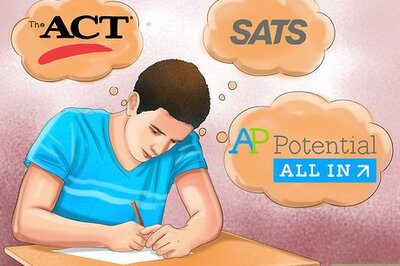
views
Yoga offers insights that can add to the list of usual suggestions like “eat frequently, exercise, drink more water, sleep well, and give up smoking and drinking”.
Energy is called ‘Prana’ in Yoga. We get energy through food, water, breathing and other impressions. This intake has to be adequate and then channelled properly in the body. Further, energy taken in must not be frittered away in wasteful activities.
Here we give some quick-fix and some long-term solutions from the Yoga way of life that can help.
RESTORING AND BUILDING ENERGY
Start the day with drinking water. ‘Break the fast’ with a tablespoon of honey and follow with soaked almonds with some jaggery. A walk in fresh air brings in energy through warming; get energy by sitting in the Sun. Also, take a walk in the early-evening Sun.
Here are some more tried-and-tested sources of energy. Remember, though, to not overdo it!
• Honey is a great restorative and helps maintain gut health
• Herbs ‘Ginseng’ or ‘Ashwagandha’, when taken with milk, improve nerve health, remove stress and restore energy
• Drink cups of water, coconut water, fresh juices, and warm fluids like clear soups and health beverages
• Take a handful of mixed nuts
• Dates and figs are a known source of energy
• A cup of brewed coffee, unless contraindicated, is beneficial
• A piece or two of dark chocolate won’t do you harm
• Eat seasonal fruits and include bananas, especially small ones, in your diet
• In extreme fatigue situations, and if not contraindicated, Glucose (Glucon D) can immediately supply energy to the brain.
Energy is maintained by eating every four hours. Remember, though, that digestion also takes up energy, so those with significant health issues need small quantities of food every two hours, and keep circulation going through fluids.
CONSERVING ENERGY
It helps to be mindful of the many ways in which we may be losing energy and here are some for illustration.
First, we lose a lot of energy through excessive talking. Then, the continuous variety of emotions we experience also draws on our energy reserves: Depression drains our energy. When angry or frightened, we breathe fast and this takes up energy. In contrast, Yogis breathe in very slowly, taking in hardly 1-2 breaths per minute — compared to the 16-18 normal — and they have such reserves that they even talk in terms of `loaning’ it! They don’t need much external nourishment and eat very little.
Next, 50 per cent of our energy is wasted through the eyes as we use them continuously to see and view. Therefore, says Yoga, relax the ciliary muscles of the eyes by closing them when there is no need to see the outside world — like when listening to music or travelling. If reading a book or working on the computer, every one hour, change the range and look at some faraway object. While watching television, change the range by simultaneously knitting or drawing. Gazing at the rising or setting Sun draws in good energy, as do `Eye-fixation exercises’ and `Trataka’.
Energy is also lost in subtle ways, like when after a bath we take up a hectic activity or rush outdoors. Post bathing, rubbing the body increases circulation at the skin level and we sweat. Similarly, after a meal, the body takes time to settle back to its normal energy management.
Finally, stress from the daily ‘work-travel-food-television-sleep’ routine depletes energy. This stress needs to be countered through recreation — that is `re-creation’ — through creative pursuits or hobbies.
GENERATING AND CHANNELING ENERGY THROUGH ASANA AND PRANAYAMA
Pranayama takes in bio-energy from outside via breathing and channels that energy. The immediate areas where Prana’s effect is seen are digestion, elimination, circulation, thoughts, and breathing.
Talking on Pranayama and ‘Connecting with Our Life Source’, Dr Jayadeva Yogendra, former Director of The Yoga Institute, Santacruz, says: “Prana is like the centre of the wheel, and all the spokes are connected to that. If we learn to manage that, we can manage life… not only enjoy good health and overcome disease, but can also possess excellent mental condition, concentrate, and be creative.”
Energy taken in from Pranayama can get blocked in places because of tight muscles or other reasons. Dr Hansaji Yogendra, Director, Yoga Institute Santacruz says if we start with Pranayama, it will not take us much further. For easy flow of Prana, we first practise Asanas and Kriyas, and also eat sensibly.
In this light, perhaps there is need to tread carefully when `using energy’ in new-age healing techniques.
Traditional Yoga believes in the composite approach. “We get energy from food, water and air. These new sciences are meddling with that by getting more energy just from air. The fact is that the body’s capacity is limited. You cannot take in more, and if you force it, it can derange you,” cautions Dr Hansaji.
This piece includes inputs from the book ‘Yoga of Caring: Talks given by Dr Jayadeva and Dr. Hansaji Yogendra’, published by the Yoga Institute Santacruz, Mumbai.
The author is a journalist, cancer survivor and certified yoga teacher. She can be reached at [email protected].




















Comments
0 comment